

|
Click here to return to Website Home page |
The following article was kindly supplied by Alan Dale.
It appears as it was written and the content has not been edited
TRANSCRIPT FROM
BUS & COACH
JANUARY 1966
A bus is as young as it acts
The policy of the
Gosport and Fareham Omnibus Co. Ltd. is to consider the suitability of vehicles
or parts for further use on a basis of fitness rather than age. A continuos
process of rebuilding has been found to be economic as well as providing useful
employment when maintenance duties are few.
It is the conventional assessment of the economic life of a bus applicable in
all circumstances? Or can it sometimes be set aside? The Gosport and Fareham
Omnibus Co. Ltd. is well known as a pioneer user of air-cooled diesel engines.
Some 11 engines of this type are now in service in modern-looking fully-fronted
double-deckers. Of the current licensed fleet of 48 double-deckers and ten
single-deckers, a further five double-deckers and all the single-deckers are
also of fully-fronted style. The citizens of the Gosport and Fareham areas no
doubt consider their local buses at least as up to date, on average, as those of
other areas.
The "front line" strength of the fleet is up to date in
conception. But the conventional system of considering that a vehicle's
usefulness is necessarily over after, say, 15 years is not accepted. On the
other hand, neither mechanical items nor bodywork are kept in service beyond the
stage at which repair is no longer economic.
The essential factor behind the way in which the company's buses, or parts of
them, can remain economic for up to twice as long as those of most other
operators is the maintenance system and the philosophy that lies behind it. If,
say, a chassis frame has been well designed and is sufficiently robustly built
to be free from fatigue failure, it can remain literally as good as new almost
indefinitely, so long as it is kept free from rust.
The wartime and post-war Guy Arab double-decker's frame was designed to carry
heavy bodywork because of the scarcity of light alloys at that time. It is not,
therefore, surprising that chassis of this type dating from between 1943 and
1948 have been chosen as a basis for the ten double-deckers with Deutz
air-cooled engines built, or rebuilt, since 1958. Five of them have come from
the company's own fleet, three were originally operated by the Yorkshire Woollen
District Transport Co. Ltd., one was owned by the Midland Red concern and the
most recent example has a chassis which originally saw service with London
Transport. The next addition to this fleet, now in course of rebuilding, has a
chassis originally owned by Red and White Services Ltd.
All of these chassis were thus originally owned by operators with a reputation
for good maintenance. In each case the chassis is brought into the Gosport and
Fareham company's workshops at Hoeford on the outskirts of Fareham and is
completely stripped. It is then rebuilt to "as new" standards, all
worn parts being replaced and the Deutz engine installed. This process is not
hurried and is treated as a task to be carried out by the maintenance staff when
work on vehicles in service permits. The "production" rate has been
one or two vehicles per year since the first vehicle appeared in 1958.
The bodywork on all these Guy-Deutz double-deckers as been of similar design,
with 56 seats and rear entrance but having a fully fronted cab. Some have been
built in their entirety by Reading and Co. Ltd., of Portsmouth, which has, in
effect, been the company's regular bodybuilder for over a decade. In some cases,
however, the Guy-Deutz buses have bodies whose timber-framed lower decks are
built to the Reading design in the Gosport and Fareham body shop and the
steel-framed upper deck is added by Reading.
The completed vehicles thus have new engines and bodywork and the chassis is
rebuilt to a standard virtually indistinguishable from new. Not surprisingly,
the vehicles receive seven-year Certificates of Fitness when submitted for
inspection before entering service. The ten vehicles of this type had between
them run nearly 1,600,000 miles by the end of last September. In addition a
Ruston and Hornsby air-cooled diesel engine fitted to a similarly reconditioned
and rebodied A.E.C. Regent chassis in July, 1964, had run over 53,000 miles.
Mr. H. Orme White, the company's general manager, is well known as an enthusiast
for the air-cooled diesel. But he can back his enthusiasm with impressive facts.
Fuel consumption figures are directly comparable with those of water-cooled
diesels with a good reputation for efficiency. In a recent week six of the
Deutz-engined Ouys returned an average of 9.8 m.p.g. and six similar Guy chassis
with Gardner 6LW engines produced an average figure of 9.46 m.p.g. The Ruston
and Hornsby engined bus returned 9.3 m.p.g. over the same period.
The Gosport and Fareham area is relatively flat, but traffic delays are becoming
an increasing problem. The company's services are predominantly urban in
character. The current fleet average fuel consumption is 9.9 m.p.g, for
weekdays, rising to 10.2 m.p.g. on Sundays because of the reduced number of
stops.
Only two of the Deutz engines have so far been dismantled. That fitted in the
first conversion, vehicle No. 59, which entered service in June, 1958, had
completed 324,815 miles by September 30 last. The second unit, in vehicle No.
61, entered service in September, 1959, and had completed 283,979 miles by
September 30 last. The latter is in some ways the more interesting unit as it
had received no special attention during its life, whereas the first had, not
unnaturally, been "fussed over" rather more as the pioneer
installation in Britain. On a recent visit to Fareham I heard this second unit
running before overhaul and it sounded as healthy as some of the newest engines.
So far as could be judged from outside, neither the Deutz nor the Ruston and
Hornsby engines are unduly noisy.
The second engine has since been dismantled and has only required relatively
minor attention to restore its condition. There have been few engine faults with
any of the air-cooled diesels, and none of these have been of a serious nature.
The policy of producing "new" buses in this way has thus proved very
successful. The use of old chassis is open to criticism on the grounds of
obsolecence. But quite a number of completely new buses due to enter service in
1966 will have similar transmission, suspension, brakes and steering‹indeed
beam axles and leaf springs remain standard on all but a minority of current
British bus models. The cost of the thorough reconditioning of the chassis is
naturally considerable, but I was assured by Mr. Orme White that the cost of the
complete vehicle is reduced sufficiently compared to new to be an economic
proposition.
The rebuilding of vehicles with air-cooled diesel engines is not the only
activity of this kind carried out by the Gosport and Fareham company. Its
approach is in some ways reminiscent of that of many tramway undertakings
towards their rolling stock. This is logical as trams were operated from the
same premises prior to 1929 by a subsidiary of the Provincial Tramways Co.‹
the company's fleetname is still "Provincial" today. A bus chassis is
the equivalent of a tramcar truck and many tramway concerns rebuilt their
vehicles by combining new bodies for existing trucks or vice versa.
The first generation of Gosport and Fareham buses, of Chevrolet make, were
replaced after a short life of about five years. Their replacements, placed in
service in 1934, were eight A.E.C. Regal 4 single-deckers with Harrington
32-seat bodies. They were also instances of the company's willingness to
pioneer, for they had diesel engines, then still uncommon particularly in what
was a small concern. Their original A.E.C. 6.6-litre four cylinder engines were
replaced by A.E.C. A173 7.7-litre six-cylinder engines in 1945-46. The Reading
concern built new fully-fronted bodywork on the vehicles in the 1957-62 period.
Thus part at least of some vehicles which have served the Gosport and Fareham
concern for 31 years are still in passenger-carrying service. Perhaps even more
remarkable is the survival of some pre-war A.E.C. Regent double-deckers complete
with their original Park Royal bodies.
Of the first two new double-deck buses purchased by the company in 1936, one is
still in service with its original body the other bus also survives but received
a new Reading body in 1955. Four other A.E.C. Regents of the 1937-39 period with
their original Park Royal bodies also remained in the fleet at the time of my
visit. The longevity of the bodywork is largely due to the original
specification of teak framing in their construction, and the company's
experience has shown that there is little to choose between teak- and
steel-framed bodywork for durability. Ash framing has a shorter life.
Mechanically the A.E.C. chassis remain substantially unchanged, although the 7.7
litre engines, originally of the Ricardo indirect-injection type, are now direct
injection units.
I was able to examine the 1936 bus during my visit and feel sure that few
passengers who ride in it can have any idea of its age. Modern bus designers
might find some useful lessons in its unladen weight, 6ton 8cwt, and the good
standard of interior finish. The combination of durability, light weight and
very fair standards of passenger amenity is remarkable.
Three 1947 Regent models with Reading bodywork also remain in the fleet and one
of these was being prepared for re-certification at the time of my visit. It was
anticipated from previous experience that it would receive a five-year
Certificate of Fitness without difficulty.
From 1948 to 1953 the Guy Arab with Gardner five cylinder SLW engine was the
company's standard choice for double-deckers. The first two had Reading bodywork
(one of these is now reconstructed as one of the Deutz engined buses, with new
bodywork), but the remaining eight were supplied with Guy bodywork of Park Royal
metal-framed design and all of these remain in service.
Even Gosport and Fareham buses cannot go on forever, and current policy is to
replace the surviving pre-war A.E.C. Regents with Guy Arabs acquired second-hand
from Southampton Corporation. Four of these, dating from 1948, were acquired in
1962 and a further seven have been purchased in the year just ended.
The Southampton vehicles have been found to be basically sound and they fit into
the Gosport and Fareham fleet particularly happily. Their Park Royal metal
framed bodywork is almost identical to the Guy-Park Royal design on some of the
company's own Guy buses. Gardner engines are also points in common, although the
ex-Southampton buses have six-cylinder 6LW units and another difference is found
in the provision of air pressure rather than vacuum brakes. The six-cylinder
engines have been found to be slightly (half m.p.g. or so) heavier on fuel than
the five-cylinder units under the local service conditions.
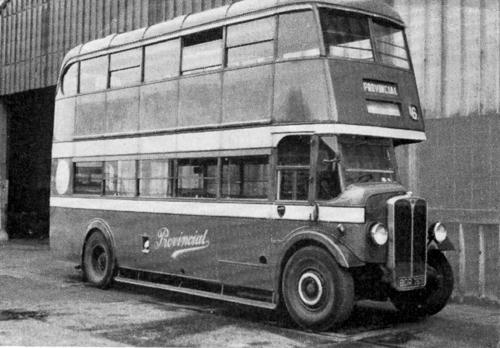
This 1936 AEC Regent is the
oldest of several Gosport and Fareham pre-war double-deckers which remain in
public service and retain their original teak-framed Park Royal bodies. The
unladen weight is 6tons 8cwt.
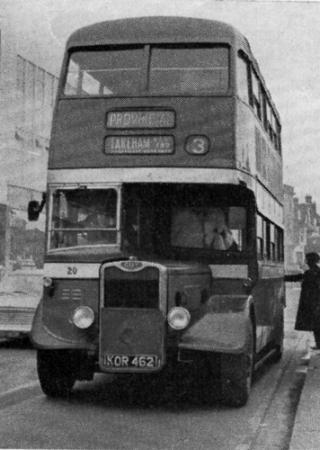
Representative of the middle
generation of Gosport and Fareham buses is this 1952 Guy Arab Mark lll with
Gardner 5LW engine and Guy-Park Royal body
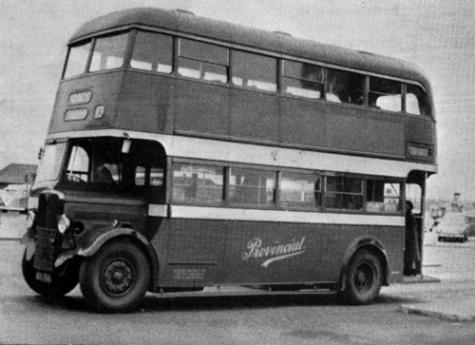
This 1936
AEC Regent with a 1955 Reading body was photographed during the mid-afternoon
off-peak at Gosport.
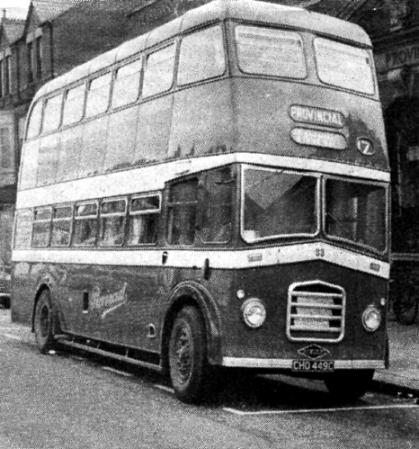
The latest addition to the
Provincial fleet operated by the Gosport and Fareham company is this Guy Arab
which entered service last August.
Although the Deutz air-cooled engine and
the bodywork were new, the extensively rebuilt chassis first entered service
with London Transport in 1945.
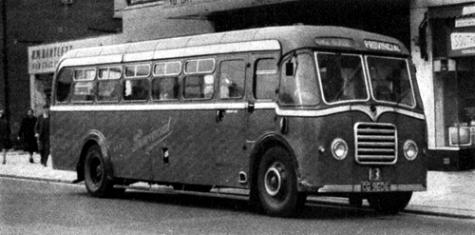
Although the Reading bodywork,
dating from 1958, on this single-decker helps to disguise its age, the AEC Regal
chassis dates from as long ago as 1934. It is shown on a Fareham local service
operated on a one-man basis.
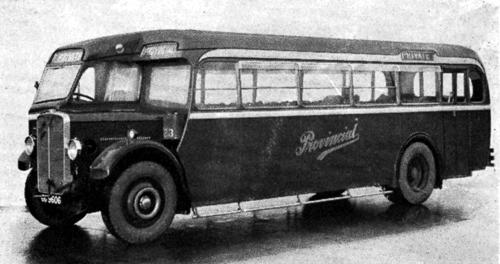
This photograph shows the same
vehicle when new over 31 years ago.
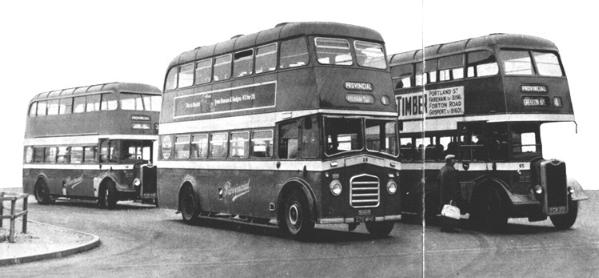
The centre vehicle in this view
taken at the Gosport terminus is an AEC Regent rebuilt in 1964 with Ruston and
Hornsby air-cooled diesel engine and new body. The Guy Arab Mark lll buses to
left and right are former Southampton Corporation vehicles acquired in 1965 and
1962, respectively.
|
Click here to return to Website Home page |